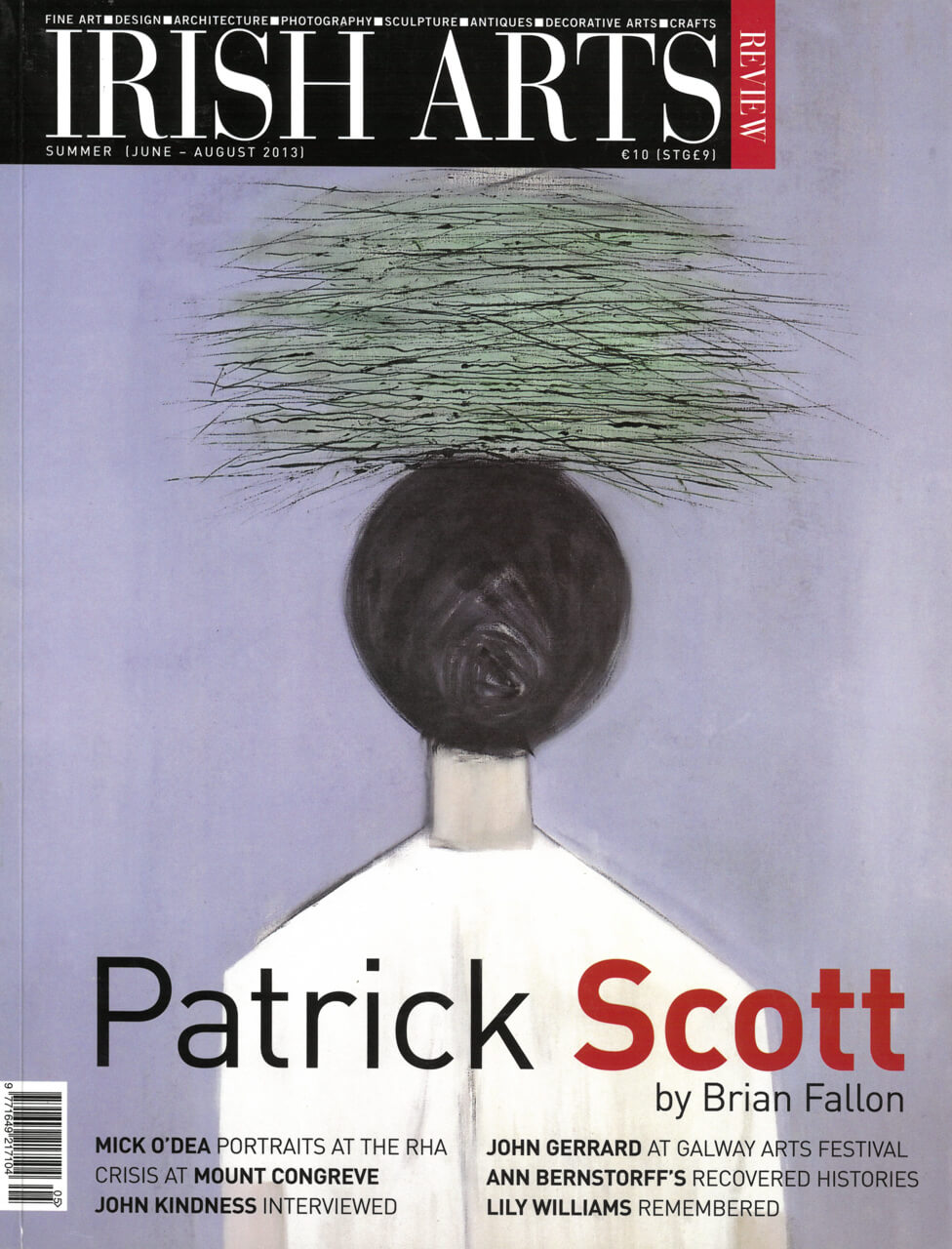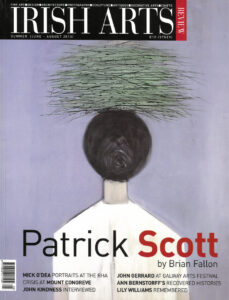

Alison FitzGerald meets Carlow-based designer Sasha Sykes, whose fusion of natural ephemera and architectural lines would satisfy both John Ruskin and Gerrit Reitveld
The Enlightenment vogue for bringing nature indoors through clever design conceits, for emphasizing links between interior spaces and exterior landscapes, and for embracing rusticity find modern parallels in the work of designer Sasha Sykes. A curious but clever dichotomy distinguishes Sykes’ work; ephemeral and organic materials are encased and re-presented in acrylic and resin supports as tables, screens, lamps and sculptural objets d’art. This unlikely marriage allows the organic to shine: one acrylic table features tendrils of ivy, which seem to escape their casing at the margins of the piece. The transparency of materials like plexiglass and resin facilitate these trompe-l’oeil effects, and belie the effort involved in achieving them. A variety of themes permeate Sykes’ work: a strong connection with the use of found materials from her immediate locality, a preoccupation with concepts of value linked to memory and nostalgia, and a whimsical sense of humour.
Born in Dublin in 1976, Sykes studied architecture in Edinburgh, a fact reflected in the clean lines and crisp geometry of much of her work. A stint as a retail designer in London followed, and after periods there (1999-2003) and in New York (2003-2006), she returned to settle in Ireland where she now works from a straw-bale studio at her home in Rathvilly, Co Carlow. At the outset of her career Sykes was drawn to the work of art and design collectives like Tomato and motivated by a desire to create an Irish equivalent with a decidedly rural slant, a gap she had identified in the market. An early, iconic work, the straw-filled plexiglass cube – a 60th-birthday gift for her bemused father – is still one of her most successful products, with variations on the theme a favourite with North American clients (Fig 3). Sykes’ company, farm21, established in 2002, aims to design and produce sculptural furniture, lighting, artworks and interior products ‘with a contemporary edge and rural twist’, defined by an article in the New York Times as ‘for people who live in the city but dream of the country’.
While there are echoes of a victorian preoccupation with preserving nature in various ways, Sykes’ natural ephemera do not fade, and are not dulled by time
A staple in her working process is an on-going and meticulous experimentation with materials. Drawn to the ‘semi-invisibility’ of acrylic and resin, and their potential for encasing manmade and organic ‘treasures’, working with them involves extensive trial and error. While hand-cut turf appealed aesthetically as a raw material for product lines, it ‘sweated’, proving difficult to use. Similarly, the process of pouring resins and avoiding unwanted bubbles in a finished work requires some skill. Even close to the end of the process extensive sanding can be required to complete a work to exacting standards. While there are echoes of a Victorian preoccupation with preserving nature in various ways, Sykes’ natural ephemera do not fade, and are not dulled by time. A UV filter in the acrylic helps flowers and leaves retain their original brilliance; resins poured in layers allow a slow and less intense heat build up than with alternatives like glass, ensuring that the visual qualities of delicate found objects are not diminished in any way. The versatility of these materials attracts Sykes and inspires her to test their limitations. While Sykes has built up an extensive client base outside Ireland, a definitive sense of the designer’s locale distinguishes much of her work. Wildflowers, thistles, seaweeds, shells and leaves evoke a strong connection with nature and the rural Irish landscape. A set of drawers, recently selected as part of the Craft Council of Ireland’s Portfolio Critical Selection 2013-14 (Fig 4) combines acrylic, traceable Irish ash and jewel-like gorse blossoms to create a strikingly original piece. Entitled Burning Gorse it would be equally at home in a rural or metropolitan interior. As Sykes explains ‘I like to re-present the incredible beauty of the rural world in another context. Working with acrylics and resins allows me to expose the textures and forms (of organic matter) within a familiar overall structure, creating a rural aesthetic for urban times.’ Unlike many practitioners she does not outsource production extensively, but pleasingly cites a team of technicians based in Rathcoole as the most proficient she has worked with on either side of the Atlantic.
A chance discovery of a bag of antique kitchen implements at home led to a series of products inspired by the objects, rare and mundane that get passed down over time, the intrinsically precious (as seen in some of the pieces from her series Family Silver, first shown at √âigse 2010), and the more humdrum. What these evoke in terms of memory, relationships, continuity and change interested her and inspired pieces like Let Them Eat Cookies (Fig 5) a humorous twist on the French ‘qu’ils mangent de la brioche’, a table in which cookie cutters and kitchen paraphernalia, vestiges of an earlier material culture are transformed and reinterpreted for a modern audience. Another piece from the Family Silver series sees Sykes casting in resin the familiar form of an antique teapot. One of the things that attracts her to materials like resins and acrylics is their heat resistance, which allows them to be used as tabletops, shelves and cubes. Conscious of the patterns of modern living she is not precious about her work, citing the practicality of a material, which can withstand a hot cup of tea, placed intentionally or otherwise on its surface. However, while much of her work is functional, she also explores the aesthetic potential of her material for creative rather than pragmatic ends. The spectral resin teapot discussed neither heats, pours, nor stores liquid, yet is none the poorer for its lack of functionality. Sykes’ captivation with cycles of life also permeates her work in various ways. An acrylic table entitled Misspent Youth is a nod to her teenage years. Studded internally with dozens of blue snooker chalks it alludes to truant hours whiled with her brother in a local pub. With The Month of November screen the memories are more recent: the young beech leaves which radiate within it were gathered with her children on daily autumnal walks to feed the family hens. Tiny fistfuls of leaves gathered over time evoke nostalgia for the passage of time.
Sykes endeavours to exhibit her work regularly in Ireland and internationally, both to reach potential clients and to inspire design development through the critical feedback she receives. Forthcoming exhibitions include the Brown Thomas showcase of Irish design, √âigse Arts Festival, Carlow, and ‘After and Since’ at Newtownbarry House Gallery, County Wexford. The last of these, a group show of work responding to the designs of Eileen Gray will see her returning to the Irish designer who inspired the monumental screen that she completed for the National Museum of Ireland in December 2010 (Fig 1) (see also Irish Arts Review Spring 2012). This time Sykes will exhibit tables inspired by Gray. She is driven in her work to achieve a balance between work that is creatively and professionally stimulating as well as commercially sustainable, a challenging task at any time, and is enthusiastic about a range of new mirror designs which she recently showed at the Ideal Homes show. Her success is reflected through the consistency with which she is selected to showcase her work in Ireland and abroad, the recognition afforded by significant institutional and corporate commissions, and the extensive coverage her work has received in design and print media internationally. The themes that she explores, in particular the passage of time and cycles of life are abiding ones, and have been skilfully reinterpreted in her work for a modern and international audience, whilst still retaining an inherently Irish dimension.
Sasha Sykes ‘√âigse Arts Festival’, Carlow 7 -16 June; and
‘After and Since’ Newtownbarry House Gallery, Co Wexford 1- 23 June 2013.
Alison FitzGerald lectures in the Department of History at NUI Maynooth.
From the IAR Archive
First published in the Irish Arts Review Vol 30, No 2, 2013



